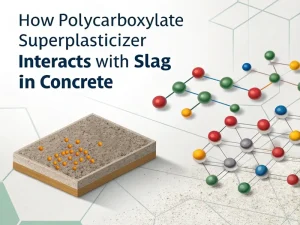Blog

Abstract: In modern concrete engineering, polycarboxylate superplasticizer has become an indispensable key component as a concrete additive, which can significantly improve the performance of concrete, increase construction efficiency, and enhance the durability of concrete structures.
TPEG 2400, as an important raw material, plays a crucial role in the synthesis of polycarboxylate superplasticizers, and its unique properties have brought numerous application breakthroughs for polycarboxylate superplasticizers.
TPEG 2400, Isopentenol polyoxyethylene ether has a specific molecular structure. Its molecular chain contains polyoxyethylene ether side chains, which endow it with good water solubility and dispersibility.
The molecular weight is about 2400, with a narrow molecular weight distribution. This moderate molecular weight allows it to effectively control the reaction process and product properties when participating in the synthesis reaction of polycarboxylate superplasticizer.
Its high retention rate of double bonds greatly enhances the product’s reactivity, thereby increasing its yield and ultimately reducing the cost of water-reducing agents.
In the synthesis process of polycarboxylate superplasticizer, TPEG 2400 can be used as a starting monomer to participate in the free radical polymerization reaction. It can undergo copolymerization reaction with unsaturated monomers such as acrylic acid and methacrylic acid under the action of initiators, forming the main chain structure of polycarboxylate superplasticizer.
Due to the active sites in its molecular structure, it can effectively initiate polymerization reactions. Its reaction activity is relatively stable, which is conducive to controlling the rate and degree of polymerization reactions, thus synthesizing polycarboxylate superplasticizer products with relatively uniform molecular weight distribution.
The polyoxyethylene ether side chains in TPEG 2400 molecules are important in constructing steric hindrance structures in polycarboxylate superplasticizer molecules.
When polycarboxylate superplasticizer is added to concrete, these side chains can stretch on the surface of cement particles, forming a thick, three-dimensional protective barrier.
This spatial hindrance effect effectively prevents the agglomeration and flocculation of cement particles, allowing them to be evenly dispersed in the concrete system. Thus, thereby significantly improving the fluidity and workability of concrete, even at lower water-cement ratios, concrete can still maintain good pumpability and construction performance.
By adjusting the proportion of TPEG 2400 in the synthesis formula of polycarboxylate superplasticizer, the water reduction rate and slump retention performance of the superplasticizer can be precisely controlled.
Appropriately increasing the dosage of TPEG 2400 can prolong the length of the molecular chain of polycarboxylate superplasticizer, increase the number of side chains, further enhance the steric hindrance effect, and thus improve the water reduction rate.
At the same time, its unique molecular structure enables the water reducer to have good slow-release performance in the concrete system, which can maintain its dispersion effect on cement particles for a long time, effectively reduce the loss of concrete slump, improve the slump retention performance of concrete, and meet the needs of long-distance transportation and long-term construction.
The polycarboxylate superplasticizer synthesized based on TPEG 2400 has made significant breakthroughs in formulating high-performance concrete. In high-rise buildings, large-span bridges, and other projects that require extremely high concrete strength, durability, and workability, this polycarboxylate superplasticizer can enable concrete to maintain high strength while having excellent fluidity and anti-segregation properties.
For example, in the concrete pumping construction of some super high-rise buildings, polycarboxylate superplasticizers containing TPEG 2400 can pump concrete to a height of hundreds of meters. The concrete can be evenly filled in the formwork during the pouring process, ensuring the integrity and compactness of the structure.
Self-compacting concrete requires extremely high fluidity and anti-segregation properties. It can fill every corner of the formwork without the need for vibration to achieve a dense state. TPEG 2400 provides strong support for the implementation of self-compacting concrete.
The polycarboxylate superplasticizer synthesized from it as a key raw material can endow concrete with excellent rheological properties. This allows concrete. This allows concrete to flow and fill smoothly under its own weight, avoid internal defects caused by insufficient vibration and improve the quality and durability of concrete structures.
This has extremely important application value in the concrete construction of some complex structural components, such as densely reinforced beam-column nodes and thin-walled structures.
With increasing environmental protection awareness, green and environmentally friendly concrete has become a development trend in the construction industry. The polycarboxylate superplasticizer synthesized by TPEG 2400 also has a positive contribution. Due to its ability to achieve high water reduction rates at lower dosages, it can effectively reduce the amount of cement used in concrete, lowering carbon emissions during concrete production.
At the same time, polycarboxylate superplasticizer has good environmental compatibility and will not release harmful formaldehyde when used in concrete. Its low content of chloride ions and sulfate ions is conducive to protecting the environment and human health, promoting the development of green building materials.
TPEG 2400 plays an irreplaceable key role in synthesising polycarboxylate water reducers. Its unique molecular structure and properties bring excellent water reduction, dispersion, and slump retention properties to polycarboxylate water reducers, making significant breakthroughs in high-performance concrete, self-compacting concrete, and green and environmentally friendly concrete applications.
With the continuous improvement of concrete performance requirements and the continuous development of material science and technology, TPEG 2400 is expected to play a more important role in future concrete engineering, further promoting innovation and progress in concrete technology.

How Polycarboxylate Polyether Monomer Affect Concrete Performance
Blog How Polycarboxylate

How Polycarboxylate Superplasticizer Interacts With Slag In Concrete
Blog How Polycarboxylate